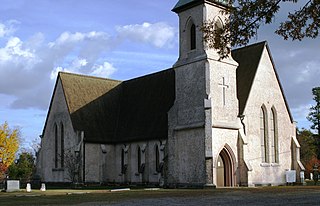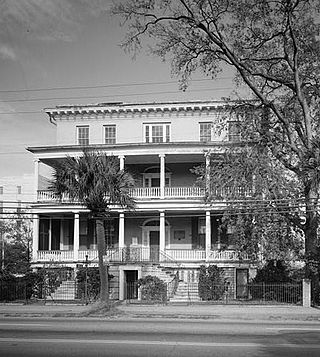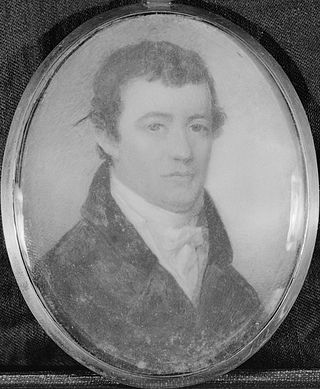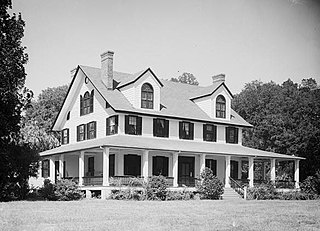
Georgetown County is a county located in the U.S. state of South Carolina. As of the 2020 census, the population was 63,404. Its county seat is Georgetown. The county was founded in 1769. It is named for George III of the United Kingdom.

Georgetown is the third oldest city in the U.S. state of South Carolina and the county seat of Georgetown County, in the Lowcountry. As of the 2010 census it had a population of 9,163. Located on Winyah Bay at the confluence of the Black, Great Pee Dee, Waccamaw, and Sampit rivers, Georgetown is the second largest seaport in South Carolina, handling over 960,000 tons of materials a year, while Charleston is the largest.

A mill dam or milldam (US) is a dam constructed on a waterway to create a mill pond.

Mansfield Plantation is a well-preserved antebellum rice plantation, established in 1718 on the banks of the Black River in historic Georgetown County, South Carolina.

Hopsewee Plantation, also known as the Thomas Lynch, Jr., Birthplace or Hopsewee-on-the-Santee, is a plantation house built in 1735 near Georgetown, South Carolina, in the Lowcountry. It was the main house of a rice plantation and the birthplace of Thomas Lynch, Jr., a Founding Father who was a signer of the Declaration of Independence.

The High Hills of Santee, sometimes known as the High Hills of the Santee, is a long, narrow hilly region in the western part of Sumter County, South Carolina. It has been called "one of the state's most famous areas". The High Hills of Santee region lies north of the Santee River and east of the Wateree River, one of the two rivers that join to form the Santee. It extends north almost to the Kershaw county line and northeasterly to include the former summer resort town of Bradford Springs. Since 1902 the town has been included in Lee County.

All Saints Church Pawleys Island is a historic church complex and national historic district located in Pawleys Island, Georgetown County, South Carolina. The district encompasses three contributing buildings and one contributing site—the sanctuary, cemetery, rectory, and chapel. In 2004, it left the Episcopal Church to join the Diocese of the Carolinas, now part of the Anglican Church in North America, a denomination within the Anglican realignment movement.

The Chicora Wood Plantation is a former rice plantation in Georgetown County, South Carolina. The plantation itself was established sometime between 1732 and 1736 and the 1819 plantation house still exists today. In 1827, Robert Francis Withers Allston (1801–1864) resigned as surveyor-general of South Carolina to take over full-time management of Chicora Wood, which he had inherited from his father. Chicora Wood served as a home base for his network of rice plantations, which produced 840,000 pounds of rice in 1850 and 1,500,000 pounds by 1860. 401 slaves worked the plantation in 1850, increasing to 630 by 1860.

The Jonathan Lucas House is a historic house in Charleston, South Carolina.

Elias Horry was a lawyer, politician, businessman and plantation owner who twice served in the South Carolina General Assembly as well as the intendant (mayor) of Charleston, South Carolina, serving two terms from 1815 to 1817 and 1820 to 1821.
Oaklyn Plantation is a historic plantation and national historic district located near Darlington, Darlington County, South Carolina. The district encompasses 40 contributing buildings, 6 contributing sites, 2 contributing structures, and contributing object. Founded as a forced-labor farm worked by black people enslaved by the land's white owners, it was one of the major plantation establishments of the county and served as the seat of the Williamson family for more than 200 years.

Annandale Plantation, originally known as Millbrook, is a historic plantation house located near Georgetown, in Georgetown County, South Carolina.
Keithfield Plantation is a historic rice plantation property and national historic district located near Georgetown, Georgetown County, South Carolina. The district encompasses 1 contributing building, 1 contributing site, and 3 contributing structures. They include a slave cabin, built about 1830, and agricultural features including examples of historic ricefields, canals, dikes, and trunks. The original main house burned in the mid-20th century. Keithfield was one of several productive rice plantations on the Black River.
Nightingale Hall Rice Mill Chimney, also known as Nightingale Plantation, is a historic rice mill chimney located near Georgetown, Georgetown County, South Carolina. This rice mill chimney is significant as one of seven known extant rice mill chimneys in Georgetown County. It is associated with Nightingale Hall, one of several productive plantations on the Pee Dee River. The chimney is approximately 29 feet high, and 6 feet square at the base.

Pee Dee River Rice Planters Historic District is a set of historic rice plantation properties and national historic district located near Georgetown, Georgetown County, South Carolina.
Fairfield Rice Mill Chimney is a historic rice mill chimney located near Georgetown, Georgetown County, South Carolina. It is one of seven known extant rice mill chimneys in Georgetown County. It was associated with Fairfield, one of several productive plantations on the Waccamaw River.
Belle Isle Rice Mill Chimney is a historic rice mill chimney and national historic district located near Georgetown, Georgetown County, South Carolina. The district encompasses one contributing site and four contributing structures. This rice mill chimney is one of seven known extant rice mill chimneys in Georgetown County and is associated with what once was one of several productive rice plantations on Cat Island. It is one of two extant rice mill chimneys in Georgetown County and measures 33 feet, 9 inches, high.
Weehaw Rice Mill Chimney is a historic rice mill chimney located near Georgetown, Georgetown County, South Carolina. This rice mill chimney is significant as one of seven known extant rice mill chimneys in Georgetown County. It is associated with Weehaw, on the Black River, which was one of the earliest successful rice plantations in the area. The chimney is approximately 35 feet high.

Wicklow Hall is a historic Plantation complexes in the Southern United States located near Georgetown, Georgetown County, South Carolina. The complex includes the house and several dependencies. Wicklow Hall is a two-story, Greek Revival style clapboard structure on a low brick foundation. The main portion of the structure was probably built between about 1831 and 1840 and enlarged by additions after 1912. Also on the property are a kitchen, corn crib, carriage house, a small house, stable, privy, and a schoolhouse. Wicklow was a major rice plantation during the mid-1800s, and associated with the prominent Lowndes family of South Carolina.
Richmond Hill Plantation Archeological Sites consists of five historic archaeological sites located near Murrells Inlet, Georgetown County, South Carolina. The Richmond Hill Plantation complex sites include remains of the planter's house, two possible overseers' houses, approximately 20 slave houses, a slave cemetery, a rice barn, and rice fields and dikes. The plantation house, overseers' houses, and slave houses were all burned by about 1930. Richmond Hill plantation was owned by Dr. John D. Magill, who was considered one of the least efficient planters in the area and the most brutal slaveowner among the Georgetown District rice planters.
















